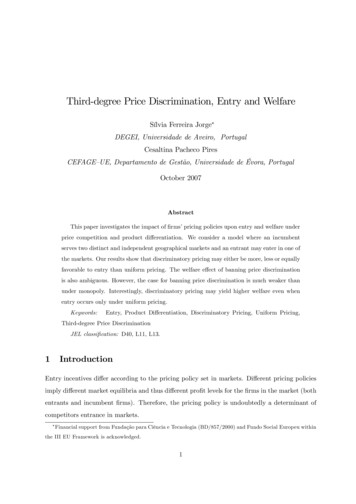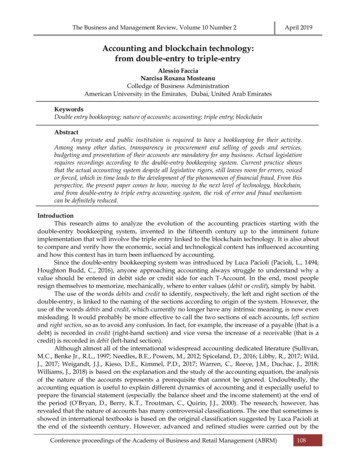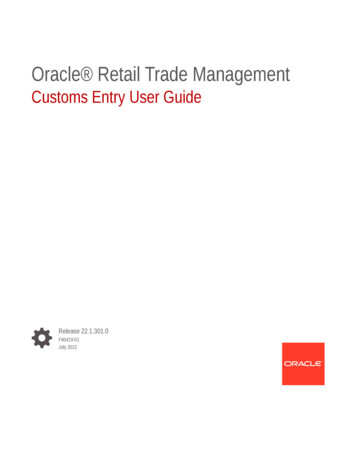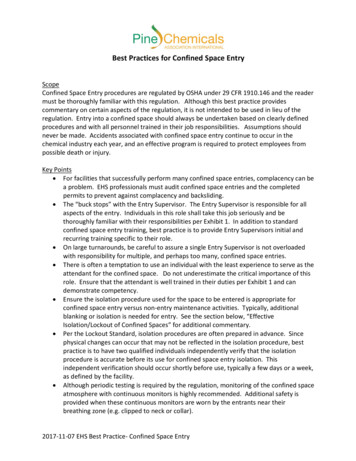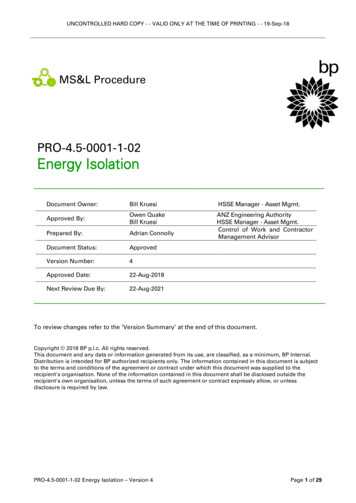
Transcription
CETA MARKET ENTRYGUIDE ON ‘AGRI-FOOD’Supporting EU business in Canada
2THE CETA AGRI-FOOD MARKET ENTRY GUIDETABLE OF CONTENTSLIST OF ACRONYMS.3EXECUTIVE SUMMARY.4How to use this Guide.4QUICK FACTS ABOUT CANADA.51. GENERAL INTRODUCTION TO THE AGRI-FOOD SECTOR IN CANADA.61.1. The Canadian agri-food sector.61.2. Agricultural production and food manufacturing.61.3. Food and beverages processing industry.62. CETA AND THE AGRI-FOOD SECTOR.92.1. Opportunities related to cheese.102.2. Opportunities related to alcoholic beverages.102.3. Opportunities related to other agri-food products.112.4. Exceptions.112.5. Canadian imports of food and beverages.123. CHALLENGES AND BARRIERS. 143.1. Analysis of obstacles and barriers.14A) Cheese and dairy products.14B) Alcoholic beverages.14C) Other technical barriers.163.2. Documentation and customs clearance.174. OVERVIEW OF THE CANADIAN AGRI-FOOD MARKET. 184.1. Introduction to Canadian agri-food market and Canada’s agri-food strategy.184.2. Size of the Canadian market, distribution structure and key players.18A) The retail sector.18B) The alcoholic beverages market.194.3. Market trends.20A) Private labels.20B) Consumer trends.204.4. Market entry strategy.23A) Doing business in Canada.23B) How to approach the Canadian market.23C) The importance of a relay in Canada.24D) Distribution channels.24E) Customs brokers.24F) Trade shows.254.5. Market entry requirements.25A) Licence requirements under the Safe Food for Canadians Act (SFCA).26B) Standard products and geographical indications.27C) Labelling requirements.27D) Safety standards.29E) Other regulations and requirements.325. TIPS FOR EU BUSINESSES. 346. CULTURAL CONSIDERATIONS. 357. STUDIES OF SUCCESSFUL EU BUSINESSES IN THE CANADIAN AGRI-FOOD SECTOR. 378. CONCLUSIONS. 39ANNEX I. RESOURCES FOR EU BUSINESSES. 40ANNEX II. EU MEMBER STATES EMBASSIES, CONSULATES AND CHAMBERS OF COMMERCE IN CANADA. 41
3THE CETA AGRI-FOOD MARKET ENTRY GUIDELIST OF ACRONYMSAIRSAutomated Import Reference SystemCBSACanadian Border Services AgencyBCLDBBC Liquor Distribution BranchCADCanadian DollarCETAComprehensive Economic and Trade AgreementCFIACanadian Food Inspection AgencyCIPOCanadian Intellectual Property OfficeCOSDCost of Service DifferentialCPLAConsumer Packaging and Labelling ActEUEuropean UnionF&BFood and BeverageFDRThe Food and Drug RegulationsGDPGross Domestic ProductGIGeographical IndicationGSTGoods and Services TaxHSHarmonised SystemIPRIntellectual Property RightsMFNMost Favoured NationNAFTANorth American Free Trade AgreementLCBOLiquor Control Board of OntarioREXRegistered Exporter systemSAQSociété des Alcools du QuébecSFCASafe Food for Canadians ActSMESmall and Medium Sized EnterprisesSPSSanitary and Phytosanitary StandardsTRQTariff Rate QuotasTQSTariff Quota SystemUSUnited States of America
THE CETA AGRI-FOOD MARKET ENTRY GUIDE4EXECUTIVESUMMARYHow to use this GuideThis guide will introduce you to the agri-food sector in Canada and how toleverage the EU-Canada Comprehensive Economic and Trade Agreement(CETA). It provides an overview of the size of the Canadian agri-food market,the distribution structure, key players and trends, as well as opportunities andchallenges for EU businesses.It explains market entry strategies and requirements of the Canadian agrifood market, including in-depth information on standards and how to registergeographical indications, labelling requirements and special requirements foralcoholic beverages, dairy products and other sensitive food products, and safetystandards. It also addresses the challenges and barriers that EU exporters canface, such as regulatory and technical requirements that have to be respected,and how EU exporters can mitigate them to export products successfully.This guide is designed to help EU businesses navigate through the requirementsand procedures to export agri-food products to Canada. It includes an extensive listof key resources for EU exporters of agricultural products to Canada.Note: All dollar figures are cited in Canadian dollars unless otherwisenoted. All euro figures have been converted from Canadian dollars usingthe InforEuro exchange rate system (November 2020).
5THE CETA AGRI-FOOD MARKET ENTRY GUIDEQUICK FACTS ABOUT CANADAThere are 10 provinces (Alberta, British Columbia, Manitoba, New Brunswick, Newfoundland and Labrador, Nova Scotia, Ontario,Prince Edward Island, Québec, and Saskatchewan) and 3 territories (Northwest Territories, Nunavut, and Yukon) in Canada. UnderCanada’s federal system, the powers of government are shared between the federal government and the 10 provincial governments.The provincial governments always play a role in their regional economic development. The federal and provincial governments haveshared jurisdiction over agriculture.Canada has the tenth largest economy in the world and is one of the world’s wealthiest nations.According to UN data, Canada is the world’s second largest country by area, with a population of 37,742,154 at mid-year 2020.32.3% of Canadians considered their ethnic origin to be Canadian. Other major groups are English (18.3%), Scottish (13.9%), French(13.6%), Irish (13.4%), German (9.6%), Chinese (5.1%), Italian (4.6%) and East Indian (4%). In 2019, 313,580 immigrants madeCanada their home. 88% of the population reside in the provinces of Ontario, Québec, British Columbia and Alberta.Figure 1. Overview of Canada s population in 2020Ontario (14,71 million)12%12%14%Québec (8,54 million)39%British Columbia (5,11 million)Alberta (4,43 million)23%OtherSources: Worldometers, Statistics Canada
THE CETA AGRI-FOOD MARKET ENTRY GUIDE61. GENERAL INTRODUCTION TO THEAGRI-FOOD SECTOR IN CANADA1.1. The Canadian agri-food sectorAgri-food includes agricultural products for final consumption (livestock, fisheries and aquaculture) and products processed by thefood industry (food and beverage).The agri-food sector is a significant contributor to Canada’s economy. As one of the world’s largest food producers, Canada is amajor player on the global agri-food stage, and is ranked as the 11th largest food producer in the world.1.2. Agricultural production and food manufacturingIn 2018, agricultural production and food manufacturing represented 6.7% of the Canadian GDP. The agri-food sector is the secondlargest manufacturing industry in Canada, generating more than 72 billion ( 112 billion) in production value, and employing anestimated 2.3 million people, accounting for 16.4% of Canadian manufacturing1.Figure 2. Canada’s top commodities by regionSource: Agribusiness - Invest in Canada, Canada Action1.3. Food and beverages processing industryThere are 6,900 businesses in the food processing industry, employing more than 270,000 people and representing more than 18%of the total manufacturing production in Canada2. 94% of the companies have less than 100 employees3. The total GDP for the foodand processing industry in Canada amounted to 17.58 billion ( 27.53 billion) in 20184.Canadian food processing companies import raw, semi-processed and processed ingredients.1 Department of Agriculture and agri-food Canada, Invest in Canada, Agri-food processing sector2 Food Processors of Canada3 FoodTech Canada4 Statista
7THE CETA AGRI-FOOD MARKET ENTRY GUIDEThe largest food and beverage processing industry is meat product manufacturing. Dairy product manufacturing is the secondlargest industry, followed by grain and oilseed milling. The other industries include: Beverage manufacturing;Bakeries and bread products;Fruit and vegetable preserving and speciality food manufacturing;Seafood product preparation and packaging;Chocolate, snacks, sugar and confectionery product manufacturing.There are major players in the global food processing industry in Canada. The majority of food processors are concentrated in theprovinces with the largest populations, near to their retail markets or distribution centres. The largest number of food manufacturersare located in Ontario.Figure 3. Number of food processing establishments by province in 2019216315831010546235209160159100706Source: StatistaThe Canadian industry supplied 70% of the food and beverage products consumed in Canada5.In 2019, the dairy manufacturers Saputo, Agropur and Parmalat/Lactalis were among the top ten companies in Canada, withcombined revenues of 15.7 billion ( 24.57 billion). At the top of the list is the Canadian company George Weston Foods, also theowner of the largest supermarket chain in Canada (Loblaws, Super Store, No Name, Provigo, Zehrs, T&T, No Frills, Maxi). Canadiansubsidiaries of major American companies (Kraft-Heinz, Pepsico, General Mills, etc.) are also well established in Canada.Table 1. Major Canadian food processors in 2019COMPANYPRODUCT GROUP2019 – REVENUE INBILLION OF CADWeston FoodsBaked goods and retail/Loblaws50.1SaputoDairy products14.9McCain Foods LimitedFrozen and packaged food10Cooperative AgropurDairy products7.3Maple Leaf FoodsProcessed meat products3.9Premium Brands Holding CorpProcessed meat and packaged products3.6Kraft Heinz CanadaPackaged goods3.5Nestlé CanadaBeverages, chocolates, coffee, packaged goods2.9Lactalis/Parmalat CanadaDairy products2.5Lassonde IndustriesFruits, beverages, sauces, snacks1.7General Mills Canada CorpCereals, snacks, frozen food, dairy, packages foods1.4SunOptaOrganic foods and beverages1.6Lantic Inc.Sugar and sweeteners0,8Source: Companies’ Annual reports5 Statista
THE CETA AGRI-FOOD MARKET ENTRY GUIDE8Canada is the fifth largest exporter of processed food and beverage products in the world. On average, food manufacturers exportabout 34% of their production, while beverage manufacturers export 11% of their products. The bulk of the food and beveragesprocessing industry exports were destined for the US market, accounting for 71% of the total. This was followed by China, Japanand the EU6.Figure 4. Exports of processed food and beverages per product sector in 2018 (in percentage)10080604020089837027SeafoodSugar andGain andConfectionary Oilseed millingMeat35Bakeryproducts36BreweriesSoft drinksSource: The Canadian Agri-Food Policy Institute, Paper on Canadian Agri-Food Processing Competitiveness, Quality Growth andGlobal Opportunities: A Snapshot of Current Trends Key FindingsIn 2019, the Canadian government announced the Canadian Agricultural Partnership (CAP), a five-year 1.91 billion ( 3 billion)investment to increase Canadian agri-food exports to 48 billion ( 75 billion).However, as only over 40% of agricultural products are purchased domestically by the Canadian food and beverage manufacturingindustry as inputs, the industry needs to import raw, semi-processed and processed ingredients to be able to expand. Due to theCanadian climate, a lot of fresh produce has to be imported, mostly from the US.While the US is Canada’s largest trading partner, partly due to their long-standing relationship, proximity and multiple ports,CETA offers a new window of opportunity for EU products. With CETA’s elimination of tariffs and other trade barriers, Canadianmanufacturers may turn more and more towards EU-sourced products.6 Statistics Canada. The Canadian Agri-Food Policy Institute, Paper on Canadian Agri-Food Processing Competitiveness, Quality Growth and GlobalOpportunities: A Snapshot of Current Trends Key Findings, March 2020, available at f
9THE CETA AGRI-FOOD MARKET ENTRY GUIDE2. CETA AND THE AGRI-FOODSECTORFollowing the provisional implementation of CETA in September 2017, Canada eliminated duties for 90.9% of all its agriculturaltariff lines. By 2023, this will increase to 91.7%. Some foods and beverage goods immediately became duty-free: alcoholic drinks,soft beverages and fruit juice, fish/crustaceans, products of animal origin, edible vegetables, fruits, nuts, coffee and tea, spices,oilseeds, grains, gums, resins/vegetable saps/extracts, vegetable products and preparations of vegetables, fruits and nuts.For sensitive agricultural products under the Canadian supply management, there is a special treatment. CETA is introducing newduty-free quotas on dairy products, according to which 16,000 tonnes of EU cheese and 700 tonnes of cheese for industrial useimports are being phased-in and will be fully available as of 2022.There is no special treatment for poultry and eggs. However, as a signatory to the WTO Agreement on Agriculture, Canadian poultryand eggs imports are regulated under tariff rate quotas (TRQs). This allows a calculated volume of this category of product toenter Canada with little or no tariff. Higher tariffs apply to volumes exceeding this set threshold. These TRQs are calculated on theCanadian poultry and egg production in the preceding calendar year. The Canadian Ministry of Global Affairs publishes the level ofTRQs for each year. The key dates and quantities for 2020/21 are available on their site7.In addition to leading to wider choice for consumers, the elimination of significant customs duties under CETA has made EU productsconsiderably more competitive in the Canadian market. EU imports into Canada have increased by 11.5%, from 3,184 million in2017 to 3,549 million in 2019.In 2019, the EU was the second largest supplier of food and beverages to Canada, after the US. Canada ranked 9th in the topdestinations of EU agri-food exports, and Canada was the 15th supplier of agricultural products to the EU, with exports valued at 2,044 million in 2019. The top EU agri-food exports were alcoholic beverages (38%), chocolate and confectionery (7%), pasta,bakery products (6%), and cheese (5%).With lower or no tariffs and easier harmonised import procedures, CETA creates new export opportunities for EU farmers andproducers across the agri-food industry, including wines and spirits, fruit and vegetables, processed products, chocolate andconfectionery, baked goods and cheese, and EU traditional specialities products.Figure 5. Top EU agri-food exports to Canada in 2019Wine, Vermouth, Cider and Vinegar ( 956 million)Chocolate, confectionery and ice cream ( 252 million)27%Spirits and liqueurs ( 220 million)44%Pasta, pastry, biscuits and bread ( 215 million)7%6%5% 5%6%Beer ( 179 million)Cheese ( 176 million)Other agri-food productsSource: European Commission, Agri-food Trade Statistical Factsheet7 trols-controles/trq-dates-ct.aspx?lang eng
THE CETA AGRI-FOOD MARKET ENTRY GUIDE102.1. Opportunities related to cheeseThanks to CETA, Canada has opened new import quotas – Tariff Rate Quotas (TRQs) on EU cheese, allowing a greater variety of cheeseand industrial cheese products from the EU to be imported into Canada at a preferential tariff rate (on a duty-free basis).Table 2. CETA cheese TRQYEARAGGREGATE ANNUAL QUANTITY(METRIC 332022 onwards16,000Source: ng engTable 3. CETA industrial cheese TRQAGGREGATE ANNUAL QUANTITY(METRIC 022 onwards1,700Source: ng engAs a result of the TRQs, EU exports of cheese to Canada increased between 2017 and 2019 by 44.3%, from 122 million to 176 million.France is the leading exporter of cheese to Canada, followed closely by Italy, surpassing by far imports from the US, which lag at3.56 million kg in 2019.Figure 6. Canadian imports of cheese from EU Member States in 2019 (in million urce: Statista2.2. Opportunities related to alcoholic beveragesFollowing the entry into force of CETA in 2017, tariffs on EU wines and spirits entering Canada were eliminated. In addition, CETAaddresses other trade barriers on spirits such as gin, vodka and whisky, which had previously hampered the EU’s ability to penetratethe Canadian market.An example of how CETA eliminates other trade barriers is the new calculation method for the cost-of-service-differential (COSD)fee imposed by certain provincial liquor boards on imported wines and spirits, which is now based on volume and not value, andcalculated in a more transparent manner. This lowered the cost for some EU producers of selling their products in Canada. Canadahas also abolished the requirements to blend imported bulk spirits with local spirits before bottling, which prevented imported bulkspirits from being labelled as GIs upon bottling in Canada.The cost-of-service-differential refers to the difference between the mark-up applied to domestic and imported spirits and wines.Under international trade law (WTO), higher mark-ups are permitted on imported products to recover the substantiated higher costsof bringing the product to the market, such as shipping, importation, and storage.There are, however, certain requirements and policies to respect to take full advantage of CETA. Please refer to the “Market entryrequirements” section.
11THE CETA AGRI-FOOD MARKET ENTRY GUIDE2.3. Opportunities related to other agri-food productsFigure 7. Opportunities related to other agri-food products Canada’s import of bread andbakery products reached 1.59 ( 2.5billion) in 2019. Italy was the 3rd top exporter toCanada (2.28% market share),France 4th (2.02%), Germany 5th(1.90%) and Belgium 8th (1.49%).The market is expected to grow by3.4% annually.Bread, pastry, cakes andbakery products Canada is an important market forchocolate from the EU. Imports in2019 reached 0.95 billion ( 1.5billion). Growth is expected tocontinue in the years to come.Belgium (5.10% imports), Germany(4.88%), France (4.18%), Italy(3.24%), and the Netherlands(1.85%) are among the top tenexporters of chocolate to Canada. Artisanal and organic and highquality dark chocolates are mostfavoured by the Canadianconsumers. The industry is valued at 2.29 billion ( 3.6 billion). Accordingto Nielsen data, it is expected toincrease by 7% annually. Canada’s import of sauces andcondiments reached 623.96 million( 977 million) in 2019. Italy was the4th top exporter with 1.59% of themarket share, France 6th (1.35%)and Germany 10th (0.93%). Themarket is expected to grow annuallyby 2.1%.Sauces and condimentsChocolates Canada’s import of pasta reached 357 million ( 559 million) in 2019.Italy was the second top supplierwith 12.73% of total import.According to Statista, Canada’smarket is evaluated at 618.85million ( 969 million) in 2020 and isexpected to grow by 2% annually. However, with the COVID-19pandemic, consumers have beenstockpiling on non-perishable items,such as pasta. It is estimated thatthe growth will be much moreimportant than previouslyestimated.Pasta According to the International olivecouncil, Canada accounts for about5% of the world imports of olive oiland olive-pomace oil, reaching closeto 153 million ( 240 million) in2019. Italy was the top supplier ofolive oil with 43.80% of totalimports, followed by Spain with22.86% of the market share. Greececame in 4th place (6.31%) andPortugal in 9th place (1.39%). By origin, around over 77% ofimports came from the EU. Themarket is expected to grow annuallyby 3%.Olive oil Canada’s imports of meat and fishpreparations reached 12.13million ( 19 million) in 2019. Italywas the 5th largest supplier with2,21% of total imports, withGermany taking the 10th place(0.99%). The market for meat preparationsis expected to shrink annually by2% and fish preparations areexpected to grow by 1.3%.Meat, fish and seafoodpreparations2.4. ExceptionsEven though Canada and the EU have agreed to establish a number of origin quotas to allow for some products to receive preferentialtariff treatment, certain agricultural products have not been offered any preferential tariff treatment by Canada under CETA, as theseproducts have not been deemed essential. Tariffs for these products could be as high as 300% Ad Valorem.These include: Broiler hatching eggs and chicks;Chicken and chicken products;Turkey and turkey products;Margarine;Butter;Wheat, barley and their products.For more information on controlled agricultural products in Canada visit Global Affairs Canada – Controlled Products.
THE CETA AGRI-FOOD MARKET ENTRY GUIDE122.5. Canadian imports of food and beveragesCanada is an important market for EU countries.Canada imports mostly high value customer-oriented products. In 2019, total Canadian imports of agri-food products representeda total of 32.57 billion ( 51 billion) (including wines and spirits).Figure 8. Top 10 EU Member States food exporters (% of total EU27 food exports to rce: Statistics CanadaFigure 9. Canadian imports by food and beverages products in million CAD in 2019Fish, crustaceans, molluscs and other aquatic3090invertebrates Oilseeds and oleaginous fruits1348Sugars and sugar confectionary1397Meat, fish and seafood preparationsChocolates and cocoaMeat and meat productsBread, pastry, cakes, biscuits and cerealsPrepared vegetables, fruits and nuts19492073240029723136Edible fruits and nutsAlcoholic beverages63715310Source: Innovation, Science and Economic Development CanadaThe proximity of the US plays a major role. In 2019, the US was the largest exporter of food and beverages to Canada, with exportsvalued at 18 billion ( 28.1 billion) (55% of the market share). The EU is the second supplier of agri-food products, with 12% ofthe market share.In 2019, the value of Canadian imports of alcoholic beverages reached 2.9 billion ( 4.5 billion), of which 1.6 billion ( 2.6 billion)was wine. The EU is the top supplier of alcoholic drinks to Canada, with France and Italy leading. With regards to wine, France, Italy,the US, Australia, and Spain were the top 5 suppliers in 2019. The exports from these 5 countries represented 79.4% of importvalue and 74.4% import volume.
13T
5 THE CETA AGRI-FOOD MARKET ENTRY GUIDE There are 10 provinces (Alberta, British Columbia, Manitoba, New Brunswick, Newfoundland and Labrador, Nova Scotia, Ontario, Prince Edward Island, Québec, and Saskatchewan) and 3 territories (Northwest Territories, Nunavut, and Yukon) in Canada. Under Canada's federal system, the powers of government are shared between the federal government and the .






